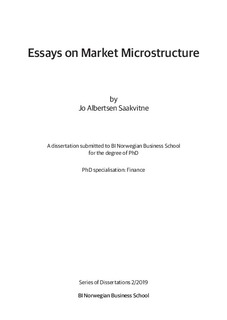| dc.description.abstract | This dissertation consists of four paper: “Fixing the fix? Assessing the Effectiveness of the 4PM Fix Benchmark”, “Trading strategies and information flow around price benchmarks”, “A note on optimal trade times for financial quotes with a last look”, and “Order
anticipation and large traders - evidence from FX markets”. In this section I provide a brief summary of each of them.
In the first paper, “Fixing the fix? Assessing the Effectiveness of the 4PM Fix Benchmark”, we examine the design and effectiveness of the 4pm Fix, the largest benchmark in FX markets. We study trading around the benchmark between 2012 and 2017 with a unique dataset that allows us to identify the actions of individual traders. These data provide new insights into how trading decisions affect the properties of the Fix benchmark, and how the presence of the Fix affects trading patterns. Two events are the particular focus of our analysis: the 2013 allegations that major banks had been colluding to rig the 4pm Fix, and the 2015 reform of the benchmark methodology.
In the second paper, “Trading strategies and information flow around price benchmarks”, I characterize equilibrium pricing and trading strategies in a competitive market where a subset of liquidity traders have a preference for executing their trades at a benchmark price. The model explains recent empirical evidence from foreign exchange markets, including those of my first chapter.
In the third paper, “A note on optimal trade times for financial quotes with a last look”, we model the option value embedded in ”last look”-quotes, building on results from option pricing theory. We introduce the time-changed discrete Levy process as a model for price dynamics, in order to account for realities of high-frequency financial prices, and we show how the optimal stopping problem associated to the quote can be solved via Least Squares Monte Carlo. For various special cases we provide explicit formulae. We also solve the optimal stopping problem for the cases where the price process follow a Brownian motion, and a Skellam process.
In the fourth paper, “Order anticipation and large traders - evidence from FX markets”, we provide novel evidence on how a major FX dealer bank adjusts its inventory before particularly large customer orders are executed. This is to our knowledge the first time such evidence is presented. We also study pre-trade price dynamics, and show that the observed price patterns differ significantly before large customer trades than at other times. Our results indicates that pre-trade price impact is a significant source of indirect trading costs for these orders. | nb_NO |
